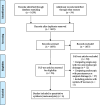Endoscopic Versus Laparoscopic Treatment for Pancreatic Pseudocysts: A Systematic Review and Meta-analysis
- PMID: 34347721
- PMCID: PMC8376268
- DOI: 10.1097/MPA.0000000000001863
Endoscopic Versus Laparoscopic Treatment for Pancreatic Pseudocysts: A Systematic Review and Meta-analysis
Abstract
Objective: The aim of the study was to evaluate the efficacy and safety of endoscopic treatment for pancreatic pseudocysts (PPCs) compared with laparoscopic treatment.
Methods: The Embase, Medline, Cochrane Library, Web of Science databases, China National Knowledge Infrastructure Chinese citation database, and WANFANG database were systematically searched to identify all comparative trials investigating endoscopic versus laparoscopic treatment for PPC. The main outcome measures included treatment success rate, adverse events, recurrence rate, operation time, intraoperative blood loss, and hospital stay.
Results: Six studies with 301 participants were included. The results suggested that there was no difference in rates of treatment success (odds ratio [OR], 0.90; 95% confidence interval [CI], 0.40-2.01; P = 0.79), adverse events (OR, 0.80, 95% CI, 0.38-1.70; P = 0.57), or recurrence (OR, 0.55, 95% CI, 0.22-1.40; P = 0.21) between endoscopic and laparoscopic treatments. However, the endoscopic group exhibited reduced operation time (weighted mean difference [WMD], -67.11; 95% CI, -77.27 to -56.96; P < 0.001), intraoperative blood loss (WMD, -65.23; 95% CI, -103.38 to -27.08; P < 0.001), and hospital stay (WMD, -2.45; 95% CI, -4.74 to -0.16; P = 0.04).
Conclusions: Endoscopic treatment might be suitable for PPC patients.
Copyright © 2021 The Author(s). Published by Wolters Kluwer Health, Inc.
Conflict of interest statement
The authors declare no conflict of interest.
Figures







References
-
- D'Egidio A, Schein M. Pancreatic pseudocysts: a proposed classification and its management implications. Br J Surg. 1991;78:981–984. - PubMed
-
- Banks PA Bollen TL Dervenis C, et al. . Classification of acute pancreatitis—2012: revision of the Atlanta classification and definitions by international consensus. Gut. 2013;62:102–111. - PubMed
-
- Rosso E Alexakis N Ghaneh P, et al. . Pancreatic pseudocyst in chronic pancreatitis: endoscopic and surgical treatment. Dig Surg. 2003;20:397–406. - PubMed
Publication types
MeSH terms
LinkOut - more resources
Full Text Sources
Medical

